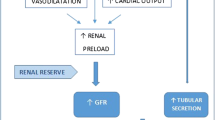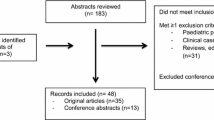Abstract
The prescription of pharmaceuticals in the critically ill represents a significant challenge, largely due to the scarcity of knowledge concerning the pharmacokinetic implications of the underlying disease state [1]. Dynamic changes in organ function can be remarkable in this population, driven by both the primary pathophysiological disturbance, and as a consequence of therapy provided. Vascular tone, capillary permeability, fluid status, cardiac output, and major organ blood flow can be significantly altered, with substantial follow-on effects on the volume of distribution and clearance of many agents.
Access this chapter
Tax calculation will be finalised at checkout
Purchases are for personal use only
Preview
Unable to display preview. Download preview PDF.
Similar content being viewed by others
References
Roberts JA, Lipman J (2009) Pharmacokinetic issues for antibiotics in the critically ill patient. Crit Care Med 37: 840–851
Albanese J, Leone M, Garnier F, Bourgoin A, Antonini F, Martin C (2004) Renal effects of norepinephrine in septic and nonseptic patients. Chest 126: 534–539
Benmalek F, Behforouz N, Benoist JF, et al (1999) Renal effects of low-dose dopamine during vasopressor therapy for posttraumatic intracranial hypertension. Intensive Care Med 25: 399–405
Brown R, Babcock R, Talbert J, Gruenberg J, Czurak C, Campbell M (1980) Renal function in critically ill postoperative patients: Sequential assessment of creatinine osmolar and free water clearance. Crit Care Med 8: 68–72
Conil JM, Georges B, Fourcade O, et al (2007) Assessment of renal function in clinical practice at the bedside of burn patients. Br J Clin Pharmacol 63: 583–594
Conil JM, Georges B, Mimoz O, et al (2006) Influence of renal function on trough serum concentrations of piperacillin in intensive care unit patients. Intensive Care Med 32: 2063–2066
Fuster-Lluch O, Geronimo-Pardo M, Peyro-Garcia R, Lizan-Garcia M (2008) Glomerular hyperfiltration and albuminuria in critically ill patients. Anaesth Intensive Care 36: 674–680
Lipman J, Wallis SC, Boots RJ (2003) Cefepime versus cefpirome: the importance of creatinine clearance. Anesth Analg 97: 1149–1154
Udy A, Roberts JA, Boots RJ, Lipman J (2009) You only find what you look for: the importance of high creatinine clearance in the critically ill. Anaesth Intensive Care 37: 11–13
Stevens LA, Coresh J, Greene T, Levey AS (2006) Assessing kidney function—measured and estimated glomerular filtration rate. N Engl J Med 354: 2473–2483
Sunder-Plassmann G, Hod WH (2004) A critical appraisal for definition of hyperfiltration. Am J Kidney Dis 43: 396
Kitzes-Cohen R, Farin D, Piva G, De Myttenaere-Bursztein SA (2002) Pharmacokinetics and pharmacodynamics of meropenem in critically ill patients. Int J Antimicrob Agents 19: 105–110
Burkhardt O, Kumar V, Katterwe D, et al (2007) Ertapenem in critically ill patients with earlyonset ventilator-associated pneumonia: pharmacokinetics with special consideration of freedrug concentration. J Antimicrob Chemother 59: 277–284
del Mar Fernandez de Gatta Garcia M, Revilla N, Calvo MV, Dominguez-Gil A, Sanchez Navarro A (2007) Pharmacokinetic/pharmacodynamic analysis of vancomycin in ICU patients. Intensive Care Med 33: 279–285
Hoste EA, Damen J, Vanholder RC, et al (2005) Assessment of renal function in recently admitted critically ill patients with normal serum creatinine. Nephrol Dial Transplant 20: 747–753
Levey AS, Bosch JP, Lewis JB, Greene T, Rogers N, Roth D (1999) A more accurate method to estimate glomerular filtration rate from serum creatinine: a new prediction equation. Modification of Diet in Renal Disease Study Group. Ann Intern Med 130: 461–470
Cockcroft DW, Gault MH (1976) Prediction of creatinine clearance from serum creatinine. Nephron 16: 31–41
Herrera-Gutierrez ME, Seller-Perez G, Banderas-Bravo E, Munoz-Bono J, Lebron-Gallardo M, Fernandez-Ortega JF (2007) Replacement of 24-h creatinine clearance by 2-h creatinine clearance in intensive care unit patients: a single-center study. Intensive Care Med 33: 1900–1906
Poggio ED, Nef PC, Wang X, et al (2005) Performance of the Cockcroft-Gault and modification of diet in renal disease equations in estimating GFR in ill hospitalized patients. Am J Kidney Dis 46: 242–252
Bone RC, Balk RA, Cerra FB, et al (1992) Definitions for sepsis and organ failure and guidelines for the use of innovative therapies in sepsis. The ACCP/SCCM Consensus Conference Committee. American College of Chest Physicians/Society of Critical Care Medicine. Chest 101: 1644–1655
Di Giantomasso D, May CN, Bellomo R (2003) Vital organ blood flow during hyperdynamic sepsis. Chest 124: 1053–1059
Wan L, Bellomo R, May CN (2007) The effects of normal and hypertonic saline on regional blood flow and oxygen delivery. Anesth Analg 105: 141–147
Di Giantomasso D, May CN, Bellomo R (2002) Norepinephrine and vital organ blood flow. Intensive Care Med 28: 1804–1809
Bosch JP, Saccaggi A, Lauer A, Ronco C, Belledonne M, Glabman S (1983) Renal functional reserve in humans. Effect of protein intake on glomerular filtration rate. Am J Med 75: 943–950
Hanes SD, Wood GC, Herring V, et al (2000) Intermittent and continuous ceftazidime infusion for critically ill trauma patients. Am J Surg 179: 436–440
Shikuma LR, Ackerman BH, Weaver RH, et al (1990) Effects of treatment and the metabolic response to injury on drug clearance: a prospective study with piperacillin. Crit Care Med 18: 37–41
Jacolot A, Incagnoli P, Edouard AR, et al (1999) Pharmacokinetics of cefpirome during the posttraumatic systemic inflammatory response syndrome. Intensive Care Med 25: 486–491
Brater DC, Bawdon RE, Anderson SA, Purdue GF, Hunt JL (1986) Vancomycin elimination in patients with burn injury. Clin Pharmacol Ther 39: 631–634
Conil JM, Georges B, Breden A, et al (2006) Increased amikacin dosage requirements in burn patients receiving a once-daily regimen. Int J Antimicrob Agents 28: 226–230
Conil JM, Georges B, Lavit M, et al (2007) Pharmacokinetics of ceftazidime and cefepime in burn patients: the importance of age and creatinine clearance. Int J Clin Pharmacol Ther 45: 529–538
Pea F, Viale P, Candoni A, et al (2004) Teicoplanin in patients with acute leukaemia and febrile neutropenia: a special population benefiting from higher dosages. Clin Pharmacokinet 43: 405–415
Fernandez de Gatta MM, Fruns I, Hernandez JM, et al (1993) Vancomycin pharmacokinetics and dosage requirements in hematologic malignancies. Clin Pharm 12: 515–520
Romano S, Fernandez de Gatta MM, Calvo MV, Caballero D, Dominguez-Gil A, Lanao JM (1999) Population pharmacokinetics of amikacin in patients with haematological malignancies. J Antimicrob Chemother 44: 235–242
Joynt GM, Lipman J, Gomersall CD, Young RJ, Wong EL, Gin T (2001) The pharmacokinetics of once-daily dosing of ceftriaxone in critically ill patients. J Antimicrob Chemother 47: 421–429
Barbot A, Venisse N, Rayeh F, Bouquet S, Debaene B, Mimoz O (2003) Pharmacokinetics and pharmacodynamics of sequential intravenous and subcutaneous teicoplanin in critically ill patients without vasopressors. Intensive Care Med 29: 1528–1534
Lugo G, Castaneda-Hernandez G (1997) Relationship between hemodynamic and vital support measures and pharmacokinetic variability of amikacin in critically ill patients with sepsis. Crit Care Med 25: 806–811
Beckhouse MJ, Whyte IM, Byth PL, Napier JC, Smith AJ (1988) Altered aminoglycoside pharmacokinetics in the critically ill. Anaesth Intensive Care 16: 418–422
Noel G, Strauss R, Shah A, Bagchi P (2008) Ceftobiprole versus ceftazidime combined with linezolid for treatment of patients with nosocomial pneumonia. ICAAC/IDSA Poster K-486 (abst)
Roberts JA, Webb SA, Paterson DL, Ho KM, Lipman J (2009) A systematic review on clinical benefits of continuous administration of beta-lactam antibiotics. Crit Care Med 37: 2071–2078
Adembri C, Fallani S, Cassetta MI, et al (2008) Linezolid pharmacokinetic/pharmacodynamic profile in critically ill septic patients: intermittent versus continuous infusion. Int J Antimicrob Agents 31: 122–129
Thallinger C, Buerger C, Plock N, et al (2008) Effect of severity of sepsis on tissue concentrations of linezolid. J Antimicrob Chemother 61: 173–176
Moise-Broder PA, Forrest A, Birmingham MC, Schentag JJ (2004) Pharmacodynamics of vancomycin and other antimicrobials in patients with Staphylococcus aureus lower respiratory tract infections. Clin Pharmacokinet 43: 925–942
Pea F, Furlanut M, Negri C, et al (2009) Prospectively validated dosing nomograms for maximizing the pharmacodynamics of vancomycin administered by continuous infusion in the critically ill patients: the Optivanco study. Antimicrob Agents Chemother 53: 1863–1867
Pea F, Porreca L, Baraldo M, Furlanut M (2000) High vancomycin dosage regimens required by intensive care unit patients cotreated with drugs to improve haemodynamics following cardiac surgical procedures. J Antimicrob Chemother 45: 329–335
Rello J, Sole-Violan J, Sa-Borges M, et al (2005) Pneumonia caused by oxacillin-resistant Staphylococcus aureus treated with glycopeptides. Crit Care Med 33: 1983–1987
Wysocki M, Delatour F, Faurisson F, et al (2001) Continuous versus intermittent infusion of vancomycin in severe Staphylococcal infections: prospective multicenter randomized study. Antimicrob Agents Chemother 45: 2460–2467
Conil JM, Georges B, de Lussy A, et al (2008) Ciprofloxacin use in critically ill patients: pharmacokinetic and pharmacodynamic approaches. Int J Antimicrob Agents 32: 505–510
Pea F, Di Qual E, Cusenza A, Brollo L, Baldassarre M, Furlanut M (2003) Pharmacokinetics and pharmacodynamics of intravenous levofloxacin in patients with early-onset ventilatorassociated pneumonia. Clin Pharmacokinet 42: 589–598
Lipman J, Scribante J, Gous AG, Hon H, Tshukutsoane S (1998) Pharmacokinetic profiles of high-dose intravenous ciprofloxacin in severe sepsis. The Baragwanath Ciprofloxacin Study Group. Antimicrob Agents Chemother 42: 2235–2239
Sun HK, Kuti JL, Nicolau DP (2005) Pharmacodynamics of antimicrobials for the empirical treatment of nosocomial pneumonia: a report from the OPTAMA Program. Crit Care Med 33: 2222–2227
Author information
Authors and Affiliations
Editor information
Editors and Affiliations
Rights and permissions
Copyright information
© 2010 Springer Science + Business Media Inc.
About this paper
Cite this paper
Udy, A.A., Roberts, J.A., Lipman, J. (2010). Augmented Renal Clearance: Unraveling the Mystery of Elevated Antibiotic Clearance. In: Vincent, JL. (eds) Intensive Care Medicine. Springer, New York, NY. https://doi.org/10.1007/978-1-4419-5562-3_46
Download citation
DOI: https://doi.org/10.1007/978-1-4419-5562-3_46
Publisher Name: Springer, New York, NY
Print ISBN: 978-1-4419-5561-6
Online ISBN: 978-1-4419-5562-3
eBook Packages: MedicineMedicine (R0)




